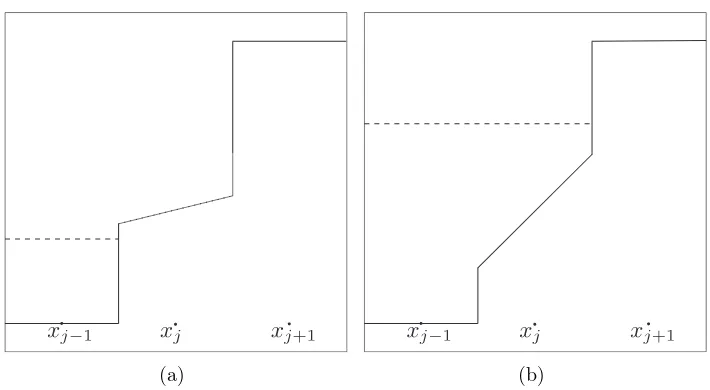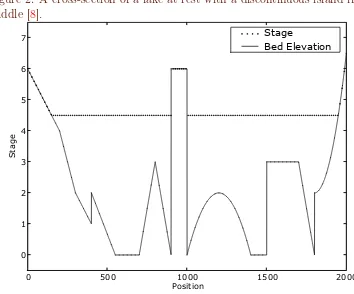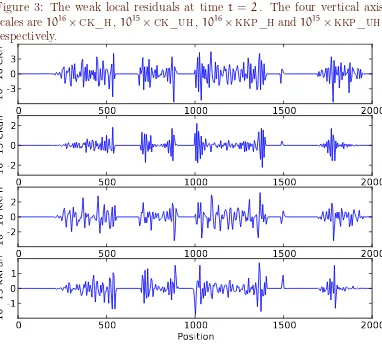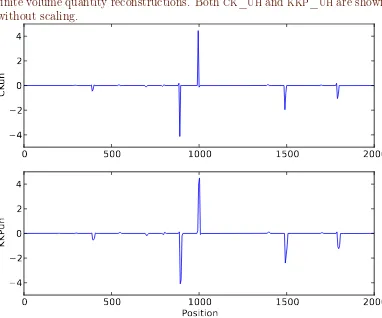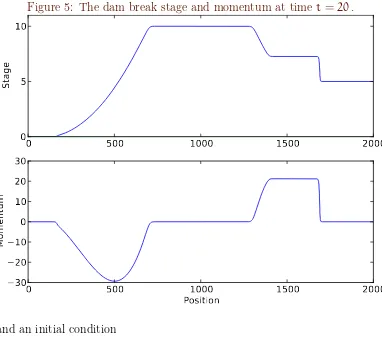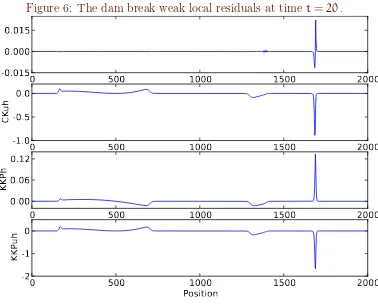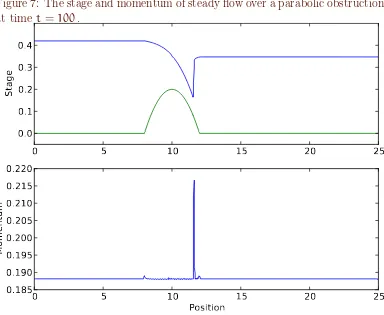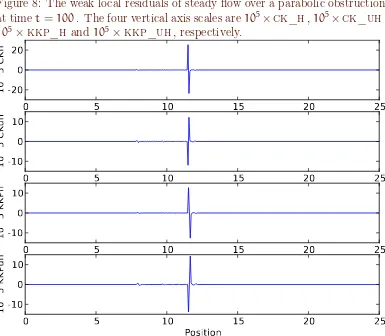ANZIAM J. 56 (CTAC2014) pp.C128–C147, 2015 C128
Well-balanced computations of weak local
residuals for the shallow water equations
Sudi Mungkasi
1Stephen G. Roberts
2(Received 2 March 2015; revised 30 November 2015)
Abstract
The one-dimensional shallow water equations describe mass con-servation and momentum concon-servation. We propose a well-balanced numerical technique for computing weak local residuals of the momen-tum equation. We compare the performance of weak local residuals of the momentum equation to those of the mass equation. All weak local residuals behave similarly.
Contents
1 Introduction C129
http://journal.austms.org.au/ojs/index.php/ANZIAMJ/article/view/9369
gives this article, c Austral. Mathematical Soc. 2015. Published December 9, 2015, as part of the Proceedings of the 17th Biennial Computational Techniques and Applications Conference.issn1446-8735. (Print two pages per sheet of paper.) Copies of this article
must not be made otherwise available on the internet; instead link directly to thisurlfor
1 Introduction C129
2 Weak local residuals for balance laws C130
3 Shallow water equations C133
3.1 Well-balancing the weak local residual . . . C134
3.2 Wet/dry interface treatment for the weak local residual . . C136
4 Numerical tests C137
4.1 Well-balanced test . . . C137
4.2 Dam break test involving a dry area and moving shock . . C141
4.3 Flow involving a stationary shock on an obstruction . . . . C141
5 Conclusions C143
References C146
1
Introduction
Karni, Kurganov and Petrova [5] originally proposed using weak local residuals (or local truncation errors) as smoothness indicators for conservation laws. The available theory supporting weak local residuals as smoothness indicators is only valid for scalar conservation laws, but with numerical experiments weak local residuals as smoothness indicators were seen to be also valid for systems of conservation laws [4, 5]. A conservation law is homogeneous and so does not have any source terms. Section2 derives the weak local residual for the scalar balance law.
2 Weak local residuals for balance laws C130
and Roberts [9] discussed measuring the smoothness of water height using mass conservation. In Section 3 we describe our numerical technique for computing the weak local residuals of the momentum equation.
Due to the existence of a source term in the momentum equation (equation of momentum conservation), the computation of the equation’s weak local residuals must be well-balanced. A non-well-balanced computation of a weak local residual may lead to spurious oscillations of the residual, leading to incorrect smoothness or error indicators. In this article we consider the steady state of a lake at rest. We develop well-balanced treatments for two different weak local residuals of the momentum equation. In addition, a wet/ dry interface treatment is also given in order to maintain the well-balanced property at wet/dry interfaces. Section 4 provides numerical tests for the performance of the weak local residuals.
2
Weak local residuals for balance laws
Kurganov et al. [4, 5] formulated the weak local residuals for conservation laws. These conservation laws are homogeneous, that is, they do not have source terms. We extend the work of Kurganov et al. [4, 5] to formulations of the weak local residuals of balanced laws. Balanced laws are conservation laws with additional nonzero source terms.
Consider the scalar balance law
qt+f(q)x =s, −∞< x <∞,
q(x,t) =q0(x), t=0.
(1)
Here x is a one-dimensional space variable, t is the time variable, q is the concentration of a quantity of interest,fis the flux ofq,sis a source function and q0 is an arbitrary function which defines the initial condition of q. Here
2 Weak local residuals for balance laws C131
problem (1) is
Z∞
0
Z∞
−∞
[q(x,t)Tt(x,t) +f(q(x,t))Tx(x,t) +s(x,t)T(x,t)]dx dt
+
Z∞
−∞
q0(x)T(x,0)dx=0, (2)
where T(x,t)is an arbitrary test function. A mathematical derivation of this weak form was derived by Knobel [6] and Smoller [12].
Given a fixed spatial step∆xand temporal step∆t, we form a uniform spatial/ temporal grid made up of discrete spatial pointsxj:= j∆xfor j=0,1, . . . ,M and temporal points tn := n∆t for n = 0,1, . . . ,N. We denote qn
j as the approximate value of q(xj,tn) computed by a conservative method. Like Karni and Kurganov [4], we denote the corresponding piecewise constant approximation as
q∆(x,t) := qjn if (x,t)∈[xj−1/2,xj+1/2]×[tn−1/2,tn+1/2], (3)
where xj±1/2 := xj ±∆x/2 and tn±1/2 := tn ±∆t/2. We construct a test function Tjn(x,t) := Bj(x)Bn(t), where Bj(x) and Bn(t) are quadratic B-splines centered at x = xj and t = tn with supports of size 3∆x and 3∆t. That is,
Bj(x) =
1 2 x−x j−3/2 ∆x
2
if xj−3/2 6x6xj−1/2, 3
4 − x−xj
∆x 2
if xj−1/2 6x6xj+1/2,
1 2
x−x j+3/2 ∆x
2
if xj+1/2 6x6xj+3/2,
0 otherwise,
(4)
and
Bn(t) =
1 2
t−tn−3/2 ∆t
2
if tn−3/2 6t6tn−1/2, 3
4 − t−tn
∆t 2
if tn−1/2 6t6tn+1/2,
1 2
t−tn+3/2 ∆t
2
if tn+1/2 6t6tn+3/2,
0 otherwise.
2 Weak local residuals for balance laws C132
Then substituting the test function Tjn(x,t) into (2) leads to a weak form of the local residual [4,5] for the balance law
Enj = −
Ztn+3/2
tn−3/2
Zxj+3/2
xj−3/2
q∆(x,t)
Tjn(x,t) t
+f(q∆(x,t))
Tjn(x,t) x+s
∆(x
,t)Tjn(x,t) dx dt. (6)
The weak local residual (6) is then
Enj = ∆x 12
qn+1 j+1 −q
n−1
j+1 +4 q n+1 j −q
n−1 j
+qn+1
j−1 −q n−1 j−1
+∆t
12
f(qn+1
j+1) −f(q n+1
j−1) +4 f(q n
j+1) −f(qnj−1)
+f(qn−1j+1) −f(q
n−1 j−1)
−∆x∆t
36
sn−1j−1 +4snj−1+s n+1 j−1
+4 sn−1j +4snj +sn+1j
+ sn−1j+1 +4snj+1+s
n+1 j+1
. (7)
Using quadratic B-splines in constructing the test function is an adaption of the work of Karni, Kurganov, and Petrova [5] on conservation laws. So we refer to the weak local residual (7) as kkp (Karni–Kurganov–Petrova).
Rather than quadratic B-splines, we can also choose localized linear B-splines as the test functions Tjn−1/2+1/2 (x,t) := Bj+1/2(x)B
n−1/2(t), where B
j+1/2(x) and Bn−1/2(t) are centered at x = xj+1/2 and t = tn−1/2 with supports of size 2∆x and 2∆t. That is,
Bj+1/2(x) =
x−xj−1/2
∆x if xj−1/26x 6xj+1/2, xj+3/2−x
∆x if xj+1/26x 6xj+3/2,
0 otherwise,
(8)
and
Bn−1/2(t) =
t−tn−3/2 ∆t if t
n−3/2 6t6tn−1/2, tn+1/2−t
∆t if t
n−1/2 6t6tn+1/2,
0 otherwise.
3 Shallow water equations C133
This results in a less expensive computation of the weak local residual
Enj+−1/21/2 = −
Ztn+1/2
tn−3/2
Zxj+3/2
xj−1/2
q∆(x,t)hTjn+−1/21/2 i
t+f(q ∆(
x,t))hTjn+−1/21/2 i
x
+s∆(x,t)Tj+1/2n−1/2dx dt, (10)
which after a straightforward computation becomes
En−1/2j+1/2 = ∆x 2
qnj −qn−1j +qnj+1−q n−1 j+1 + ∆t 2
f qn−1 j+1
−f qn−1
j
+f qnj+1
−f qnj
− ∆x∆t
4
sn−1 j +s
n j +s
n−1 j+1 +s
n j+1
. (11)
Using linear B-splines to construct the test function is an adaption of the work of Constantin and Kurganov [3] on conservation laws. So we refer to the weak local residual (11) as ck (Constantin–Kurganov).
3
Shallow water equations
The shallow water equations are
ht+ (hu)x = 0, (12)
(hu)t+ hu2+ 12gh2
x = −ghzx. (13)
Here, x is the coordinate in one-dimensional space, t is time, u(x,t)denotes the water velocity, h(x,t) denotes the water height, z(x) is the topography, andg is the acceleration due to gravity. Another quantity of interest is the stage w=w(x,t) which is the water surface elevation given by w=h+z.
3 Shallow water equations C134
indicators for balance laws may lead to spurious oscillations of the indicator values. We show an example of this problem in Section 4. The problem is caused by source terms in the balance laws. To make the indicators work properly, we need to make the computation of the indicators well-balanced.
Mungkasi and Roberts [9] presented weak local residuals of the mass equation (equation of mass conservation) as smoothness indicators. No well-balanced technique was needed in that case since the mass equation does not have a source term. In the next two subsections we focus on well-balancing the weak local residual of the non-homogeneous momentum equation. We limit our discussion on the well-balanced technique to the steady state of a lake at rest.
3.1
Well-balancing the weak local residual
We propose a well-balanced technique for computing weak local residuals of the non-homogeneous momentum equation (13) in wet regions.
Consider the non-homogeneous momentum equation (13) and the weak local residual (7). For the steady state of a lake at rest, the weak local residual (7) simplifies to
Enj =
∆t 12
f(qn+1
j+1) −f(q n+1 j−1)
−∆x∆t
36
sn+1 j+1 +4s
n+1 j +s
n+1 j−1
+∆t
3
f(qnj+1) −f(q n j−1) − ∆x∆t 9
snj+1+4s n j +s
n j−1 +∆t 12
f(qn−1j+1) −f(qn−1j−1)
− ∆x∆t
36
sn−1j+1 +4sn−1j +sn−1j−1
. (14)
In the case of a still lake f(qb a) =
1 2g(h
b
a)2. For our indicator to be well-balanced for the still lake case we need
[f(qj+1) −f(qj−1)] =
∆x
3 [sj+1+4sj+sj−1], (15)
3 Shallow water equations C135
Table 1: Discrete values for the source terms in kkp and ck.
kkp terms Discrete values ck terms Discrete values
sj−1 −ghj−1
zj+1−zj−1
2∆x sj −ghj
zj+1−zj
∆x
sj −g
hj+1+hj−1
2
zj+1−zj−1
2∆x sj+1 −ghj+1
zj+1−zj
∆x sj+1 −ghj+1
zj+1−zj−1
2∆x
Since the fluxes in (15) are defined at the (j−1)th and (j+1)th cells, we need to enforce that the source term discretisations involve only the (j−1)th and (j+1)th cells. That is, we take sj = 21(sj+1+sj−1). Equation (15) is then rewritten as
g 2
(hj+1)2− (hj−1)2
=∆x[sj+1+sj−1]. (16)
Next, we use the same value for the topography gradientzx in the formulations ofsj+1 and sj−1, so that hj+1−hj−1 =zj−1−zj+1 for the lake at rest. This is achieved by discretising
(zx)j+1= (zx)j−1 := (zj+1−zj−1)/(2∆x). (17)
This last enforcement guarantees the well-balanced computation of the weak local residual (7). This source term discretisation technique is adapted from numerical schemes originally proposed by Bermudez and Vazquez [2]. This technique was also used by Audusse et al. [1] and Noelle et al. [10] to develop well-balanced numerical schemes. Each source term in kkp (7) and its discretisation using the above technique is given in the first and second column of Table 1, respectively.
3 Shallow water equations C136
3.2
Wet/dry interface treatment for the weak local
residual
The well-balanced technique describe in Section 3.1is valid for all-wet regions, that is, the(j−1)th,jth, and(j+1)th cells are wet. A numerical treatment at a wet/dry interface is needed and we describe it here. We omit the description of a dry/wet treatment, as it is similar to the treatment of a wet/dry interface.
We solve the shallow water equations using the finite volume method described by Mungkasi and Roberts [8]. We implement the discretisation proposed by Audusse et al. [1]. Quantities are reconstructed based on heighth, stage w:= h+z, and velocity u. We implement the wet/dry interface reconstruction, proposed by Audusse et al. [1]. The wet/dry interface reconstruction adjusts the bed topography z if negative water height occurs, so that the water height h remains nonnegative [1,8, for more details]. A second order method with a minmod limiter is used [11].
Since thekkpindicator of thejth cell involves three cells, namely the(j−1)th,
jth, and(j+1)th cells, there are two cases of the wet/dry interface for the kkpindicator: (a) wet-dry-dry, that is, wet for the (j−1)th cell, dry for the
jth cell, dry for the (j+1)th cell; and (b) wet-wet-dry, that is, wet for the
(j−1)th cell, wet for the jth cell, dry for the(j+1)th cell. These two cases are illustrated in Figure1. In the computation of thekkpindicator for these cases, zj+1 is replaced by wj−1. This ensures that the indicator computation at the wet/dry interface remains well-balanced. The two remaining special cases, namely wet-dry-wet and dry-wet-dry, are assumed to have indicator values of zero.
4 Numerical tests C137
Figure 1: Two cases of the wet/dry interface for thekkpindicator: (a) the wet-dry-dry case; (b) the wet-wet-dry case. The dashed horizontal line indicates the water level.
(a) (b)
4
Numerical tests
We test the performance of weak local residuals. We use the second order well-balanced finite volume method [8]. Quantities are measured in siunits.
4.1
Well-balanced test
Consider a lake at rest with a discontinuous island in the middle of the lake, illustrated in Figure 2. This test is an adaptation of the test of Mungkasi and Roberts [8]. In the computation, the spatial domain is discretised into
800 cells.
4 Numerical tests C138
Figure 2: A cross-section of a lake at rest with a discontinuous island in the middle [8].
Stage
Bed Elevation
0 500 1000 1500 2000
Position 0
1 2 3 4 5 6 7
S
ta
ge
residuals of the mass and momentum equations based on (11), while kkp_h and kkp_uh are the weak local residuals of the mass and momentum equations based on (7). All indicators are the correct weak local residuals of the steady state of a lake at rest, correct to the order of10−15 (machine precision).
4 Numerical tests C139
Figure 3: The weak local residuals at time t = 2. The four vertical axis scales are 1016×ck_h,1015×ck_uh, 1016×kkp_hand1015×kkp_uh,
respectively.
0 500 1000 1500 2000
-3 0 3
10
^
16
C
K
h
0 500 1000 1500 2000
-2 0 2
10
^
15
C
Ku
h
0 500 1000 1500 2000
-2 0 2
10
^
16
K
K
Ph
0 500 1000 1500 2000
Position -1
0 1
10
^
15
K
K
Pu
4 Numerical tests C140
Figure 4: Unphysical weak local residuals at time t=2. Hereck_uh and
kkp_uh are computed naïvely using local cell quantity values based on
finite volume quantity reconstructions. Bothck_uh andkkp_uhare shown without scaling.
0 500 1000 1500 2000
−4 −2 0 2 4
C
Ku
h
0 500 1000 1500 2000
Position −4
−2 0 2 4
K
K
Pu
4 Numerical tests C141
reconstructions. In this case, ck_uh and kkp_uh have large indicator values at some points, although these values should actually be zero.
4.2
Dam break test involving a dry area and moving
shock
Consider the collapse of a reservoir on a horizontal topography [9]
z(x) =0, 0 < x < 2000, (18)
with initial velocity and stage
u(x,0) =0, w(x,0) =
0 if 0 < x < 500,
10 if 500 < x < 1500,
5 if 1500 < x < 2000.
(19)
The simulation illustrates the motion of the water at any point x in the domain and at any time t > 0 with respect to the initial condition (19). Condition (19) describes two dam walls (at x=500 and x =1500). In the computation, the spatial domain is discretised into 800cells.
The simulation results at time t=20 are shown in Figures5and 6. Figure5
shows the stage and the corresponding momentum value. The weak local residualsck_h, ck_uh, kkp_h, andkkp_uh are shown in Figure 6. The ck_h indicator is best at identifying the shock.
4.3
Flow involving a stationary shock on an
obstruction
Consider a channel of length 25 with a parabolic bump topography [9]
z(x) =
0.2−0.05(x−10)2 if 86x 612,
4 Numerical tests C142
Figure 5: The dam break stage and momentum at time t =20.
0
500
1000
1500
2000
0
5
10
Sta
ge
0
500
1000
1500
2000
Position
−30
−20
−10
0
10
20
30
Mo
me
ntu
m
and an initial condition
u(x,0) =0, w(x,0) =0.33, (21)
together with the Dirichlet boundary conditions
[w,hu,z,h,u] = [0.42,0.18,0.0,0.42,0.18/0.42] at x=0−
, (22)
[w,hu,z,h,u] = [0.33,0.18,0.0,0.33,0.18/0.33] at x=25+
. (23)
In the computation, the spatial domain is discretised into 400 cells.
The simulation results at time t=100are shown in Figures7and8. Figure7
5 Conclusions C143
Figure 6: The dam break weak local residuals at time t=20.
0 500 1000 1500 2000
-0.015 0.000 0.015
C
K
h
0 500 1000 1500 2000
-1.0 -0.5 0.0
C
Ku
h
0 500 1000 1500 2000
0.00 0.06 0.12
K
K
Ph
0 500 1000 1500 2000
Position -2
-1 0
K
K
Pu
h
ck_h, ck_uh,kkp_h, and kkp_uh are shown in Figure 8. More details of these results are given by Mungkasi [7].
5
Conclusions
5 Conclusions C144
Figure 7: The stage and momentum of steady flow over a parabolic obstruction at timet =100.
0
5
10
15
20
25
0.0
0.1
0.2
0.3
0.4
Sta
ge
0
5
10
15
20
25
Position
0.185
0.190
0.195
0.200
0.205
0.210
0.215
0.220
Mo
me
ntu
m
shallow water equations, which are a system of balance laws. This suggests that weak local residuals may also be used as smoothness indicators for a system of balance laws in general, as long as an appropriate well-balanced treatment is used.
5 Conclusions C145
Figure 8: The weak local residuals of steady flow over a parabolic obstruction at timet=100. The four vertical axis scales are105×ck_h,105×ck_uh,
105×kkp_h and 105×kkp_uh, respectively.
0 5 10 15 20 25
-20 0 20
10
^
5
C
K
h
0 5 10 15 20 25
-10 0 10
10
^
5
C
Ku
h
0 5 10 15 20 25
-10 0 10
10
^
5
K
K
Ph
0 5 10 15 20 25
Position -10
0 10
10
^
5
K
K
Pu
References C146
References
[1] E. Audusse, F. Bouchut, M. O. Bristeau, R. Klein, and B. Perthame. A fast and stable well-balanced scheme with hydrostatic reconstruction for shallow water flows. SIAM J. Sci. Comput.25:2050–2065, 2004.
doi:10.1137/S1064827503431090. C135, C136
[2] A. Bermudez and M. E. Vazquez. Upwind methods for hyperbolic conservation laws with source terms. Comput. Fluids, 23:1049–1071, 1994. doi:10.1016/0045-7930(94)90004-3. C135
[3] L. A. Constantin and A. Kurganov. Adaptive central-upwind schemes for hyperbolic systems of conservation laws. In F. Asakura,
S. Kawashima, A. Matsumura, S. Nishibata, K. Nishihara (Eds.)
Hyperbolic problems: Theory, numerics, and applications. Vol. 1 of Proceedings of the 10th international conference, Osaka, Japan, 13–17 September 2004, Yokohama Publishers, Yokohama, 2006, pages 95–103, 2006. http://www.ybook.co.jp/pub/ISBN4-946552-21-9.htm,
http://129.81.170.14/~kurganov/Constantin-Kurganov.pdf C133
[4] S. Karni and A. Kurganov. Local error analysis for approximate
solutions of hyperbolic conservation laws. Adv. Comput. Math. 22:79–99, 2005. doi:10.1007/s10444-005-7099-8 C129, C130, C131,C132
[5] S. Karni, A. Kurganov, and G. Petrova. A smoothness indicator for adaptive algorithms for hyperbolic systems. J. Comput. Phys.
178:323–341, 2002. doi:10.1006/jcph.2002.7024 C129, C130, C132
[6] R. Knobel. An Introduction to the Mathematical Theory of Waves. American Mathematical Society, Providence, 2000.
http://www.ams.org/bookstore-getitem/item=stml-3 C131
References C147
Australian National University, Canberra, 2012.
http://hdl.handle.net/1885/10301 C143
[8] S. Mungkasi and S. G. Roberts. On the best quantity reconstructions for a well balanced finite volume method used to solve the shallow water wave equations with a wet/dry interface. ANZIAM J. 51:C48–C65, 2009
http://journal.austms.org.au/ojs/index.php/ANZIAMJ/article/
view/2576 C136, C137, C138
[9] S. Mungkasi and S. G. Roberts. Numerical entropy production for shallow water flows. ANZIAM J. 52:C1–C17, 2010. http://journal.
austms.org.au/ojs/index.php/ANZIAMJ/article/view/3786 C130,
C134, C141
[10] S. Noelle, N. Pankratz, G. Puppo, and J. R. Natvig. Well-balanced finite volume schemes of arbitrary order of accuracy for shallow water flows. J. Comput. Phy. 213:474–499, 2006. doi:10.1016/j.jcp.2005.08.019 C135
[11] P. L. Roe. Characteristic-based schemes for the Euler equations. Ann. Rev. Fluid Mech. 18:337–365, 1986.
doi:10.1146/annurev.fl.18.010186.002005 C136
[12] J. Smoller. Shock Waves and Reaction-Diffusion Equations.
Springer-Verlag, New York, 1983. doi:10.1007/978-1-4612-0873-0 C131
Author addresses
1. Sudi Mungkasi, Department of Mathematics, Sanata Dharma University, Yogyakarta, Indonesia.
mailto:[email protected]
2. Stephen G. Roberts, Mathematical Sciences Institute, Australian National University, Canberra,Australia.

